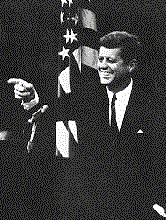FRtR > Outlines > American History (1990) > Chapter Eight > Efforts towards world peace (17/22)
An Outline of American History (1990)
Chapter Eight
Efforts towards world peace (17/22)
< Previous Page * Next Page >
In March 1961 President Kennedy initiated the project
known as the Peace Corps-a revolutionary idea in foreign
assistance. The program enlisted volunteers for service in
developing countries all over the globe. Young Americans in particular
found the program attractive and put their talents to work as
nurses, surveyors, teachers, mechanics, health and sanitation
specialists, and farm aides. The Peace Corps, besides promoting
grass-roots development abroad, sought to build international
understanding, good will, and peace.
The Kennedy years saw also the signing of the limited
nuclear test-ban treaty. In August 1961, the very month the Berlin
wall went up, the Soviet Union announced that it would resume
testing nuclear weapons in the atmosphere, thus ending the
voluntary moratorium on atmospheric testing initiated three years
earlier by the Soviet Union, Great Britain, and the United States.
On September 1 the Soviet Union began a series of nuclear
explosions in the atmosphere. Tests such as these produced large
amounts of radioactive fallout and aroused worldwide fears of
genetic damage to future generations.
 Despite the breaking of the
moratorium, President Kennedy
continued to urge the Soviet Union to sign an agreement
providing for international inspection that would assure a ban on
all future tests. When this offer was rejected, the United States
reluctantly announced that it had no alternative but to resume
its own testing in the atmosphere to maintain an effective
deterrent capacity. At the same time, the U.S. Government continued
to work for an end to the arms race by creating a special Arms
Control and Disarmament Agency and by maintaining its endeavor
to obtain a test-ban treaty.
Despite the breaking of the
moratorium, President Kennedy
continued to urge the Soviet Union to sign an agreement
providing for international inspection that would assure a ban on
all future tests. When this offer was rejected, the United States
reluctantly announced that it had no alternative but to resume
its own testing in the atmosphere to maintain an effective
deterrent capacity. At the same time, the U.S. Government continued
to work for an end to the arms race by creating a special Arms
Control and Disarmament Agency and by maintaining its endeavor
to obtain a test-ban treaty.
These efforts finally bore fruit in July 1963 when the Soviet
Union, Great Britain, and the United States initialed a treaty
outlawing nuclear explosions in outer space. By the end of the year,
107 nations had subscribed to the treaty. The question of
underground testing was left to the future, since the Soviet Union
continued to reject the kind of on-site inspection that could
accurately detect such tests.
Some observers believed that the Soviet government's
willingness to accept even a partial test-ban was traceable to the
missile crisis in Cuba, which had brought the world to the brink of
nuclear war. As a further precaution against the possibility of the
outbreak of a nuclear war through accident or
misunderstanding, a direct teletype connection-popularly referred to as "the
hot line"- was established between the White House in
Washington and the Kremlin in Moscow.
These safeguards against accidental war and the
contamination of the atmosphere reflected a fresh approach to
Soviet-American relations. In a notable speech at Washington's
American University in June 1963, President Kennedy proposed a
thaw in the cold war.
"We must conduct our affairs in such a way," he said, "that
it becomes in the Communists' interest to agree on a genuine
peace. Above all, while defending our own vital interests, nuclear
powers must avert those confrontations which bring an adversary
to a choice of either a humiliating retreat or a nuclear war.... To
secure these ends, America's weapons are nonprovocative,
carefully controlled, designed to deter, and capable of selective use.
Our military forces are committed to peace and disciplined in
self-restraint.... The United States, as the world knows, will
never start a war."
America was directing its energies, the
President concluded, "not toward a strategy of annihilation but
toward a strategy of peace."
< Previous Page * Next Page >
 Despite the breaking of the
moratorium, President Kennedy
continued to urge the Soviet Union to sign an agreement
providing for international inspection that would assure a ban on
all future tests. When this offer was rejected, the United States
reluctantly announced that it had no alternative but to resume
its own testing in the atmosphere to maintain an effective
deterrent capacity. At the same time, the U.S. Government continued
to work for an end to the arms race by creating a special Arms
Control and Disarmament Agency and by maintaining its endeavor
to obtain a test-ban treaty.
Despite the breaking of the
moratorium, President Kennedy
continued to urge the Soviet Union to sign an agreement
providing for international inspection that would assure a ban on
all future tests. When this offer was rejected, the United States
reluctantly announced that it had no alternative but to resume
its own testing in the atmosphere to maintain an effective
deterrent capacity. At the same time, the U.S. Government continued
to work for an end to the arms race by creating a special Arms
Control and Disarmament Agency and by maintaining its endeavor
to obtain a test-ban treaty.